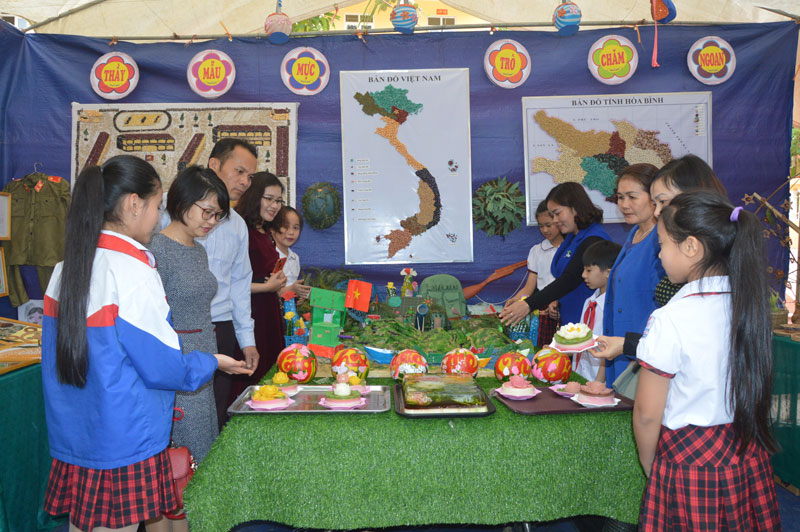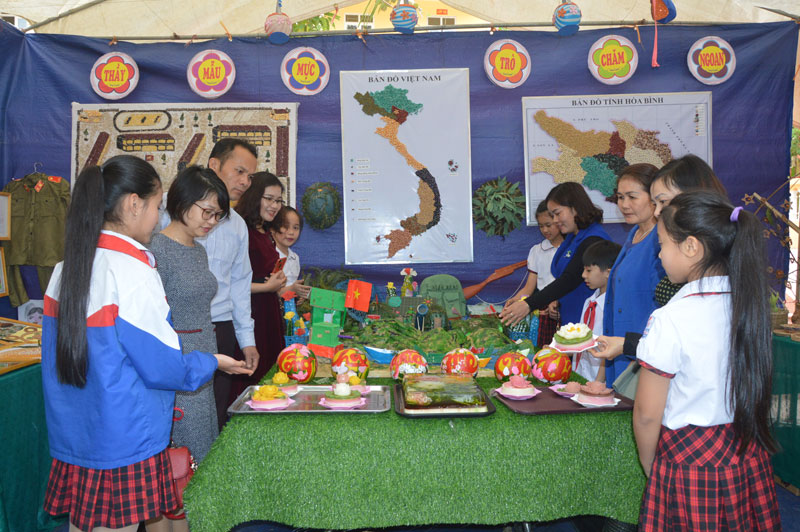
(HBO) – Kim Tien Primary School (Kim Tien commune, Kim Boi district), was selected by the Hoa Binh Department of Education and Training to organise a creative fine arts experience programme, themed "We follow the tradition of Uncle Ho’s soldiers”, to mark the 74th founding anniversary of the Vietnam People's Army (VPA) and 29 years of the All-People's Defence Festival (December 22).

Products on display reflect pupils’skillsand creativity.
The programme was a practical activity to support teaching at school, creating a useful playingfield
to form and develop necessary qualifications
for pupils, particularlylife
skills. Through creative experiences inthe subject of finearts, the quality of education and life
skill training could be evaluated, while pupils are encouraged
to uphold the tradition of "when you eat a fruit, think of the man who planted
the tree”, thus being grateful to soldiers and showing their love
and pride for their homeland. The experiences are also expected to increase
pupils’ interest in learning and love for their schools.
Participating in the event, primary schools in Kim Boi
district installed booths featuring the major theme. Their booths were
classified into the categories of "Rembering the glorious history of the VPA”
showcasing creative products; "Inspiring Little Chefs” and "We are field cooks”
with local products and cusine; and "Following our ancestors” for creative
paintings and crafts.
Pupils were excited to join various activities, including
3D painting, clay modeling, creative painting, and upcycled fashion designing./.
With an increasingly vibrant and widespread emulation movement aimed at building cultured residential areas and cultured families, Yen Thuy District has been making steady progress toward improving both the material and spiritual well-being of its people, while fostering a civilized, prosperous, beautiful, and progressive community.
Once lacking recreational spaces and community facilities, Residential Group 2 in Quynh Lam Ward (Hoa Binh City) has recently received attention for the construction of a new, spacious, and fully equipped cultural house. The project followed the model of state support combined with public contributions in both labor and funding.
The "All people unite to build cultural life" movement, which has been effectively integrated with Kim Boi district’s socio-economic development goals, is fostering a lively spirit of emulation across local residential areas, hamlets, villages, public agencies, and enterprises. In addition, through the initiative, traditional cultural values are being preserved and promoted, while community solidarity and mutual support in poverty reduction and economic development are being strengthened.
A working delegation of the Hoa Binh provincial People’s Committee led by its Permanent Vice Chairman Nguyen Van Toan on June 11 inspected the progress of a project to build the Mo Muong Cultural Heritage Conservation Space linked to tourism services in Hop Phong commune, Cao Phong district.
Born and growing in the heroic land of Muong Dong, Dinh Thi Kieu Dung, a resident in Bo town of Kim Boi district, in her childhood was nurtured by the sweet lullabies of her grandmother and mother. These melodies deeply imprinted on her soul, becoming an inseparable part of her love for her ethnic group's culture. For over 20 years, this love for her hometown has driven Dung to research, collect, and pass down the cultural values of the Muong people to future generations.
In the final days of May, the Ethnic Art Troupe of Hoa Binh Province organized performances to serve the people in remote, mountainous, and particularly disadvantaged areas within the province. These were not just ordinary artistic shows, but they were the meaningful journeys aimed at spreading cultural values, enhancing the spiritual life of the people and contributing to the preservation of ethnic minority cultural identities.



